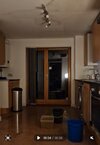Hi all,
Does anyone have expertise/experience of water damage to fireboard who could share some guidance?
I suffered a leak into my kitchen from upstairs neighbour. She's a difficult person and kept turning mains back on, so I had gallons pouring in for on/off 4 days. Ceiling was on brink of collapse. For context, it would fill 4 x 10L buckets in about 2 hours.
Buildings insurer is now making good damage to my flat. Great.
The ceiling make up is one layer plasterboard, metal stud framing, followed by 2 layers of fireboard, and then upstairs subfloor. I know this as I had another nasty leak years ago in bathroom.
Insurer sent contractor in last week who took down 1st layer plasterboard, but has said no need to remove fireboard as its not damaged as far as he can see from exposed underside and any risk of mould mitigated as it'll be trapped within the ceiling space.
When I had bathroom leak, the fireboard was taken down and it was in an ugly state, covered in mould, sandwiched between the two sheets.
The insurer has approved removal so I don't understand why they wouldn't replace it, but they're saying it just isn't necessary.
I'm planning to call Knauf / British Gypsum tomorrow for technical advice, but does anyone know if exposure to that much water would cause lasting damage? Would it warrant replacement? Is there a risk of mould or would it really be trapped?
I don't want to have the work done then start seeing mould in 6 months, and need to go through the process again.
Many thanks
Does anyone have expertise/experience of water damage to fireboard who could share some guidance?
I suffered a leak into my kitchen from upstairs neighbour. She's a difficult person and kept turning mains back on, so I had gallons pouring in for on/off 4 days. Ceiling was on brink of collapse. For context, it would fill 4 x 10L buckets in about 2 hours.
Buildings insurer is now making good damage to my flat. Great.
The ceiling make up is one layer plasterboard, metal stud framing, followed by 2 layers of fireboard, and then upstairs subfloor. I know this as I had another nasty leak years ago in bathroom.
Insurer sent contractor in last week who took down 1st layer plasterboard, but has said no need to remove fireboard as its not damaged as far as he can see from exposed underside and any risk of mould mitigated as it'll be trapped within the ceiling space.
When I had bathroom leak, the fireboard was taken down and it was in an ugly state, covered in mould, sandwiched between the two sheets.
The insurer has approved removal so I don't understand why they wouldn't replace it, but they're saying it just isn't necessary.
I'm planning to call Knauf / British Gypsum tomorrow for technical advice, but does anyone know if exposure to that much water would cause lasting damage? Would it warrant replacement? Is there a risk of mould or would it really be trapped?
I don't want to have the work done then start seeing mould in 6 months, and need to go through the process again.
Many thanks


